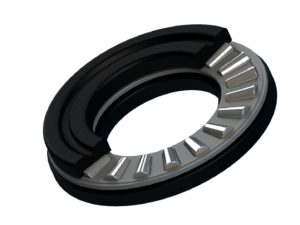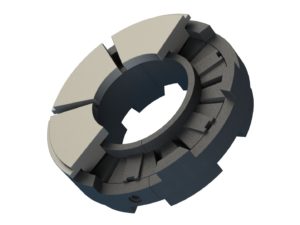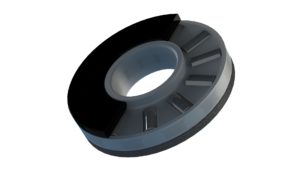Thrust, or thrust race bearings, are designed to support an axial (or thrust) load using a rolling element like a ball or roller. An axial load is when the force is applied along the axis of a structure, for example, when the load is transmitted linearly along a shaft. The ‘classic’ thrust race bearing design consists of rollers or balls supported by a cage or ring. Sometimes there are raceways or washers above and below the rolling elements.
A versatile bearing, they can be designed to meet a variety of specifications. You can have a one-way or two-way thrust bearing by stacking them, so one can spin one way and the other in the opposite direction, plus, they can be made with specific rolling elements, or integrated with a radial bearing to support both radial and axial loads.
Benefits of BNL thrust bearings:
- Integrated designs that save component cost and assembly time
- Lightweight for smaller motor use and power saving
- Inherent noise dampening characteristics of plastics
- No need for lubrication that could leech out
- Component combinations and design potential to meet varied specifications
BNL make both ball and roller thrust bearings, commonly using cages to ensure alignment and smooth, balanced operation. If there is misalignment in the thrust bearing, not only does it affect performance and efficiency, but it will lead to uneven wear and the premature failure of the bearing.
We supply different types of thrust bearings to customers ranging from large, robust bearings for high load support, to tiny, thin bearings for precision movement. We can design and manufacture to meet the required footprint, load and environmental condition, such as temperature, dust or chemical exposure.
We specialise in integrating the raceways into mating parts, via plastic injection moulding, integrating the thrust bearing with a shaft and we can provide the thrust bearing with raceways and washers.
If all you need is the thrust bearing cage, we can also supply these, designed and moulded to specification.
Types of Thrust Bearing
A thrust bearing can be designed to support different loads, speeds and specifications, simply by changing the type of element used to transmit movement. Different types of rolling element have different amounts of contact area – the larger the contact area of the rolling element, the higher the load it can support.
These can be grouped into two elements – ball bearings and rollers.

Ball Bearing Thrust Bearing
- Simple design for assembly/disassembly
- Axial load only
- A low load bearing
- Can by single or bi-directional
- Low running torque
- Relatively quiet
Roller Thrust Bearings
There are for main types on roller thrust bearing. The type of roller determines the load the thrust bearing can support.
Cylindrical roller bearings manage only limited thrust loads. Spherical roller bearings can accommodate misalignment and more thrust, and, when doubled up, thrust in either direction. Tapered roller bearings can manage significant thrust loads. Needle bearings, a variant of cylindrical roller bearings, can handle high radial loads for their size, and can be made as needle roller thrust bearings.
Cylindrical Roller Thrust Bearings
- Simple design for assembly/disassembly
- Axial load only
- Can handle a higher load than the ball version
- Has a balanced surface contact for even wear
- Can wear more quickly than the ball version under varying radial speeds
- Less chance of misalignment versus a ‘flat’ thrust bearing
- Higher running torque than a ball thrust bearing
Spherical Roller Thrust Bearing
The rolling elements in spherical roller bearings are not actually spherical in shape. They are a type of roller with a barrel-like profile, rather than a cylindrical profile as above.
- Can accommodate angular misalignment
- Can handle more axial load than cylindrical rollers
- Radial & axial loads
- Suitable for moderate speeds
- Can be back to back to support axial load in two directions

Tapered Roller/ Asymmetrical Roller Thrust Bearing
- Supports axial and radial loads
- Can handle high loads from axial and radial directions compared to ball version
- Has a balanced surface contact for even wear
- Can be in back-to-back pairs to support axial forces from either direction
Needle Roller Thrust Bearing
- Slim, small rollers for a lighter weight bearing
- Suitable when space is at a premium
- Higher load capacity than a ball version
Flat Thrust Bearing
- Eq
 uivalent of a plain or sleeve bearing in a thrust bearing
uivalent of a plain or sleeve bearing in a thrust bearing - High surface area equates to faster wear than other types
- High torque to rotate
- Not suitable if there is a potential for misalignment. If misaligned the running torque and surface wear increases, resulting in more wear and reduced life
Fluid film thrust bearing
Otherwise known as a floating thrust bearing, Kingsbury or Michell bearing, these do not have a rolling element and defy the usual definition.
They have paddles or floating pads instead of rolling elements and can operate under high loads and speeds.
Thrust Bearing Materials
For both ball and roller types of thrust bearings the raceways are usually hardened steel, but the cages can be plastic or steel.
In our ball thrust bearings we use steel balls. In our roller, thrust bearings, we can use steel or plastic rollers, dependent on application.
We can provide the bearings with or without lubrication.
Where are thrust bearings used?
- Ball – Cameras, fans, toys, bikes, steering adjustment
- Roller – Steering column, gear boxes
- Fluid – Heavy duty applications, e.g., propeller shafts, power station equipment
Thrust bearings have been a key product for BNL for many years and we have worked on a variety of different applications. Just a few of our projects are listed below:
- Camera lenses – very small thrust bearings used for smooth rotation of the lens. BNL designed integrated retention features into the thrust bearing to allow it to be fitted easily. This way other moving parts of the lens adjustment mechanism could circumnavigate the thrust bearing and all operational parts are harmonised.
- Floor standing fans and air-purifiers – a custom designed and integrated thrust bearing mechanism that allows the product to rotate to cool or purify air throughout a room. The thrust race is designed for easy assembly of the product, reducing components and overall product weight, and provide smooth and quiet operation.
- Tilt and rake, manual adjust steering columns – Provided a more cost effective, lighter weight equivalent to a steel bearing in the adjustment mechanism.
- High-end TV and stand adjustment – BNL designed and created a large ball thrust bearing to provide very smooth, quiet movement for a luxury brand rotating TV and stand. Manufactured in segments for easy shipping and storing of inventory, the thrust bearing features a cage with oval pockets so balls can self-centre and integrated friction brakes for precise, effortless operation.
Do you think a plastic thrust bearing might bring advantages to your product development? We offer a machine tear down service, where we can investigate ways in which our plastic thrust bearings could benefit the performance and efficiency of your product.
ARE YOUR THRUST BEARINGS OVER SPECIFIED?
Where extreme load carrying capability is not needed, you could benefit from a fully plastic, lightweight thrust bearing that can be custom designed for cost, space, weight or assembly process savings.
ASK AN ENGINEER ABOUT YOU THRUST BEARING REQUIREMENTS AND SEE IF A BETTER VALUE THRUST BEARING IS SUITABLE FOR YOUR APPLICATION





 Back
Back
